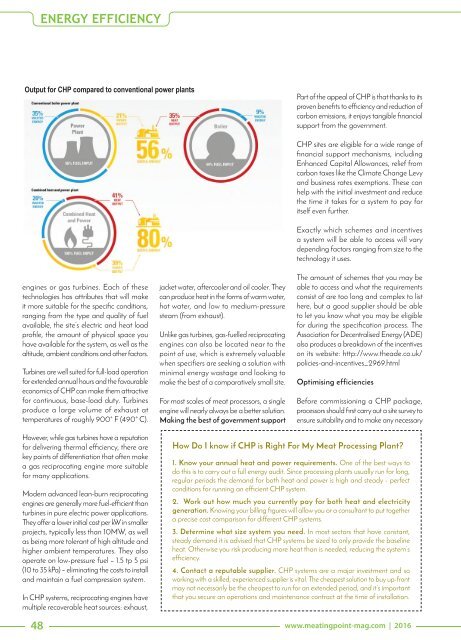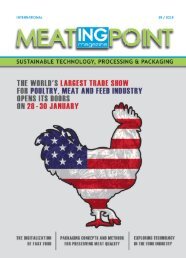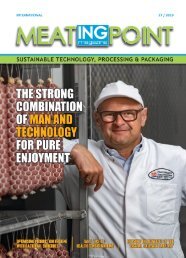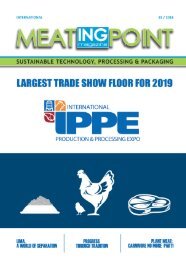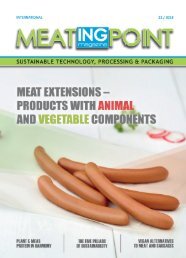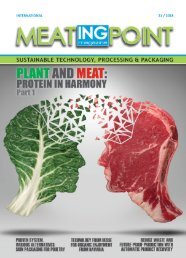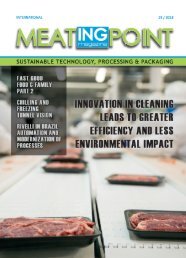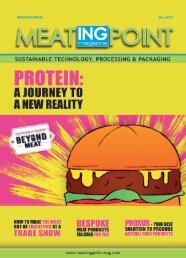MEATing POINT Magazine: #08/ 2016
You also want an ePaper? Increase the reach of your titles
YUMPU automatically turns print PDFs into web optimized ePapers that Google loves.
ENERGY EFFICIENCY<br />
Output for CHP compared to conventional power plants<br />
Part of the appeal of CHP is that thanks to its<br />
proven benefits to efficiency and reduction of<br />
carbon emissions, it enjoys tangible financial<br />
support from the government.<br />
engines or gas turbines. Each of these<br />
technologies has attributes that will make<br />
it more suitable for the specific conditions,<br />
ranging from the type and quality of fuel<br />
available, the site’s electric and heat load<br />
profile, the amount of physical space you<br />
have available for the system, as well as the<br />
altitude, ambient conditions and other factors.<br />
Turbines are well suited for full-load operation<br />
for extended annual hours and the favourable<br />
economics of CHP can make them attractive<br />
for continuous, base-load duty. Turbines<br />
produce a large volume of exhaust at<br />
temperatures of roughly 900° F (490° C).<br />
jacket water, aftercooler and oil cooler. They<br />
can produce heat in the forms of warm water,<br />
hot water, and low to medium-pressure<br />
steam (from exhaust).<br />
Unlike gas turbines, gas-fuelled reciprocating<br />
engines can also be located near to the<br />
point of use, which is extremely valuable<br />
when specifiers are seeking a solution with<br />
minimal energy wastage and looking to<br />
make the best of a comparatively small site.<br />
For most scales of meat processors, a single<br />
engine will nearly always be a better solution.<br />
Making the best of government support<br />
CHP sites are eligible for a wide range of<br />
financial support mechanisms, including<br />
Enhanced Capital Allowances, relief from<br />
carbon taxes like the Climate Change Levy<br />
and business rates exemptions. These can<br />
help with the initial investment and reduce<br />
the time it takes for a system to pay for<br />
itself even further.<br />
Exactly which schemes and incentives<br />
a system will be able to access will vary<br />
depending factors ranging from size to the<br />
technology it uses.<br />
The amount of schemes that you may be<br />
able to access and what the requirements<br />
consist of are too long and complex to list<br />
here, but a good supplier should be able<br />
to let you know what you may be eligible<br />
for during the specification process. The<br />
Association for Decentralised Energy (ADE)<br />
also produces a breakdown of the incentives<br />
on its website: http://www.theade.co.uk/<br />
policies-and-incentives_2969.html<br />
Optimising efficiencies<br />
Before commissioning a CHP package,<br />
processors should first carry out a site survey to<br />
ensure suitability and to make any necessary<br />
However, while gas turbines have a reputation<br />
for delivering thermal efficiency, there are<br />
key points of differentiation that often make<br />
a gas reciprocating engine more suitable<br />
for many applications.<br />
Modern advanced lean-burn reciprocating<br />
engines are generally more fuel-efficient than<br />
turbines in pure electric power applications.<br />
They offer a lower initial cost per kW in smaller<br />
projects, typically less than 10MW, as well<br />
as being more tolerant of high altitude and<br />
higher ambient temperatures. They also<br />
operate on low-pressure fuel – 1.5 tp 5 psi<br />
(10 to 35 kPa) – eliminating the costs to install<br />
and maintain a fuel compression system.<br />
In CHP systems, reciprocating engines have<br />
multiple recoverable heat sources: exhaust,<br />
How Do I know if CHP is Right For My Meat Processing Plant?<br />
1. Know your annual heat and power requirements. One of the best ways to<br />
do this is to carry out a full energy audit. Since processing plants usually run for long,<br />
regular periods the demand for both heat and power is high and steady - perfect<br />
conditions for running an efficient CHP system.<br />
2. Work out how much you currently pay for both heat and electricity<br />
generation. Knowing your billing figures will allow you or a consultant to put together<br />
a precise cost comparison for different CHP systems.<br />
3. Determine what size system you need. In most sectors that have constant,<br />
steady demand it is advised that CHP systems be sized to only provide the baseline<br />
heat. Otherwise you risk producing more heat than is needed, reducing the system’s<br />
efficiency.<br />
4. Contact a reputable supplier. CHP systems are a major investment and so<br />
working with a skilled, experienced supplier is vital. The cheapest solution to buy up-front<br />
may not necessarily be the cheapest to run for an extended period, and it’s important<br />
that you secure an operations and maintenance contract at the time of installation.<br />
48 www.meatingpoint-mag.com | <strong>2016</strong>


